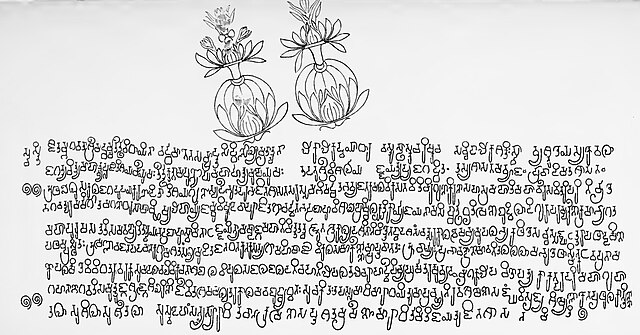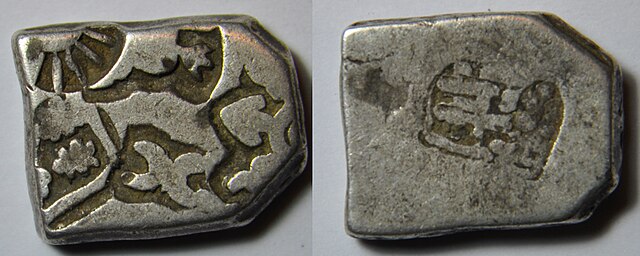Chandragupta Maurya was the founder of the Maurya Empire, a geographically-extensive empire based in Magadha. He reigned from 320 BCE to 298 BCE. The Magadha kingdom expanded to become an empire that reached its peak under the reign of his grandson, Ashoka the Great, from 268 BCE to 231 BCE. The nature of the political formation that existed in Chandragupta's time is not certain. The Mauryan empire was a loose-knit one with large autonomous regions within its limits.
A modern statue depicting Chandragupta Maurya, Laxminarayan Temple, Delhi
7th-century Bhadrabahu inscription at Shravanabelagola (Sanskrit, Purvahale Kannada script). This is the oldest inscription at the site, and it mentions Bhadrabahu and Prabhacandra. Lewis Rice and Digambara Jains interpret Prabhacandra to be Chandragupta Maurya, while others such as J F Fleet, V. R. Ramachandra Dikshitar, and Svetambara Jains state this interpretation is wrong.
Chandragupta's guru was Chanakya, with whom he studied as a child and with whose counsel he built the Empire. This image is a 1915 attempt at depicting Chanakya.
Chandragupta had defeated the remaining Macedonian satrapies in the northwest of the Indian subcontinent by 317 BCE.
The Maurya Empire was a geographically extensive Iron Age historical power in South Asia based in Magadha. Founded by Chandragupta Maurya in 322 BCE, it existed in loose-knit fashion until 185 BCE. The empire was centralized by the conquest of the Indo-Gangetic Plain; its capital city was located at Pataliputra. Outside this imperial centre, the empire's geographical extent was dependent on the loyalty of military commanders who controlled the armed cities scattered within it. During Ashoka's rule, the empire briefly controlled the major urban hubs and arteries of the Indian subcontinent excepting the deep south. It declined for about 50 years after Ashoka's rule, and dissolved in 185 BCE with the assassination of Brihadratha by Pushyamitra Shunga and foundation of the Shunga dynasty in Magadha.
Pataliputra, capital of the Mauryas. Ruins of pillared hall at Kumrahar site.
The Pataliputra capital, discovered at the Bulandi Bagh site of Pataliputra, 4th–3rd c. BCE.
A silver coin of 1 karshapana of the Maurya empire, period of Bindusara Maurya about 297–272 BC, workshop of Pataliputra. Obv: Symbols with a sun. Rev: Symbol. Dimensions: 14 × 11 mm. Weight: 3.4 g.
Lion Capital of Ashoka at Sarnath. c. 250 BCE.








